child seat FIAT BARCHETTA 2003 1.G Owners Manual
[x] Cancel search | Manufacturer: FIAT, Model Year: 2003, Model line: BARCHETTA, Model: FIAT BARCHETTA 2003 1.GPages: 170, PDF Size: 3.55 MB
Page 7 of 170
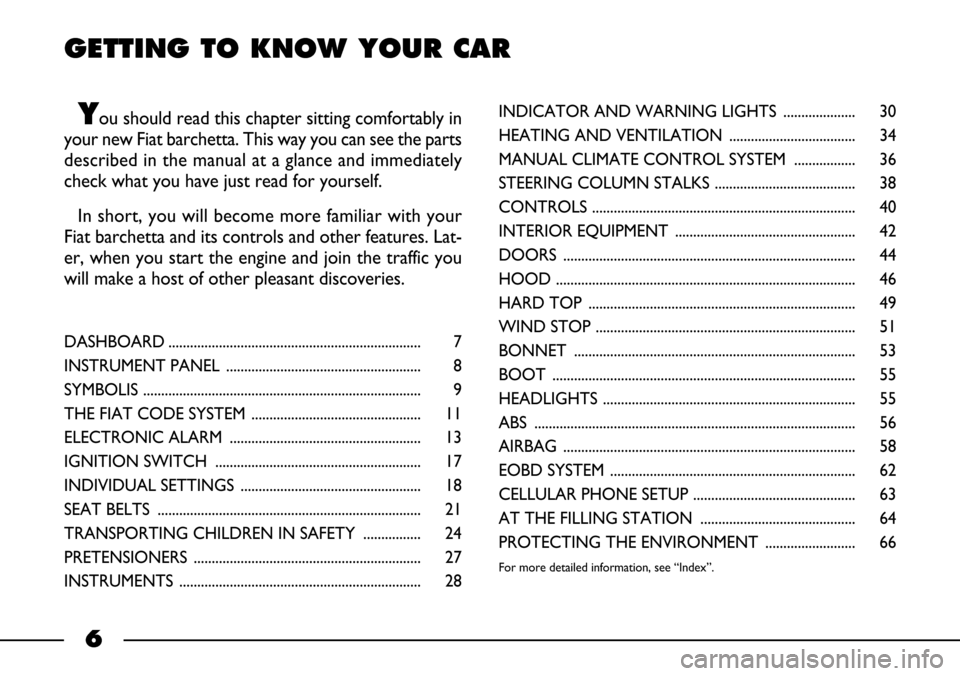
GETTING TO KNOW YOUR CAR
You should read this chapter sitting comfortably in
your new Fiat barchetta. This way you can see the parts
described in the manual at a glance and immediately
check what you have just read for yourself.
In short, you will become more familiar with your
Fiat barchetta and its controls and other features. Lat-
er, when you start the engine and join the traffic you
will make a host of other pleasant discoveries.
DASHBOARD ...................................................................... 7
INSTRUMENT PANEL ...................................................... 8
SYMBOLIS ............................................................................. 9
THE FIAT CODE SYSTEM ............................................... 11
ELECTRONIC ALARM ..................................................... 13
IGNITION SWITCH ......................................................... 17
INDIVIDUAL SETTINGS .................................................. 18
SEAT BELTS ......................................................................... 21
TRANSPORTING CHILDREN IN SAFETY ................ 24
PRETENSIONERS ............................................................... 27
INSTRUMENTS ................................................................... 28INDICATOR AND WARNING LIGHTS .................... 30
HEATING AND VENTILATION ................................... 34
MANUAL CLIMATE CONTROL SYSTEM ................. 36
STEERING COLUMN STALKS ....................................... 38
CONTROLS ......................................................................... 40
INTERIOR EQUIPMENT .................................................. 42
DOORS ................................................................................. 44
HOOD ................................................................................... 46
HARD TOP .......................................................................... 49
WIND STOP ........................................................................ 51
BONNET .............................................................................. 53
BOOT .................................................................................... 55
HEADLIGHTS ...................................................................... 55
ABS ......................................................................................... 56
AIRBAG ................................................................................. 58
EOBD SYSTEM .................................................................... 62
CELLULAR PHONE SETUP ............................................. 63
AT THE FILLING STATION ........................................... 64
PROTECTING THE ENVIRONMENT ......................... 66
For more detailed information, see “Index”.
6
Page 11 of 170
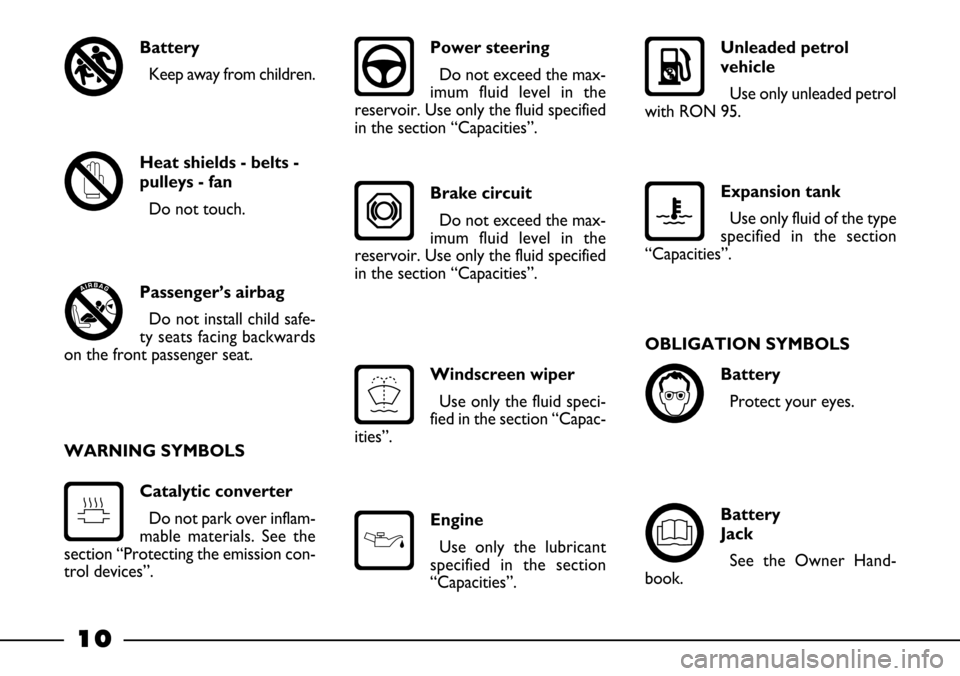
Unleaded petrol
vehicle
Use only unleaded petrol
with RON 95.
Expansion tank
Use only fluid of the type
specified in the section
“Capacities”.
Battery
Jack
See the Owner Hand-
book.Battery
Protect your eyes.
Engine
Use only the lubricant
specified in the section
“Capacities”. Windscreen wiper
Use only the fluid speci-
fied in the section “Capac-
ities”.Brake circuit
Do not exceed the max-
imum fluid level in the
reservoir. Use only the fluid specified
in the section “Capacities”.
Catalytic converter
Do not park over inflam-
mable materials. See the
section “Protecting the emission con-
trol devices”.Power steering
Do not exceed the max-
imum fluid level in the
reservoir. Use only the fluid specified
in the section “Capacities”.
Passenger’s airbag
Do not install child safe-
ty seats facing backwards
on the front passenger seat.Heat shields - belts -
pulleys - fan
Do not touch. Battery
Keep away from children.
10
WARNING SYMBOLSOBLIGATION SYMBOLS
Page 19 of 170
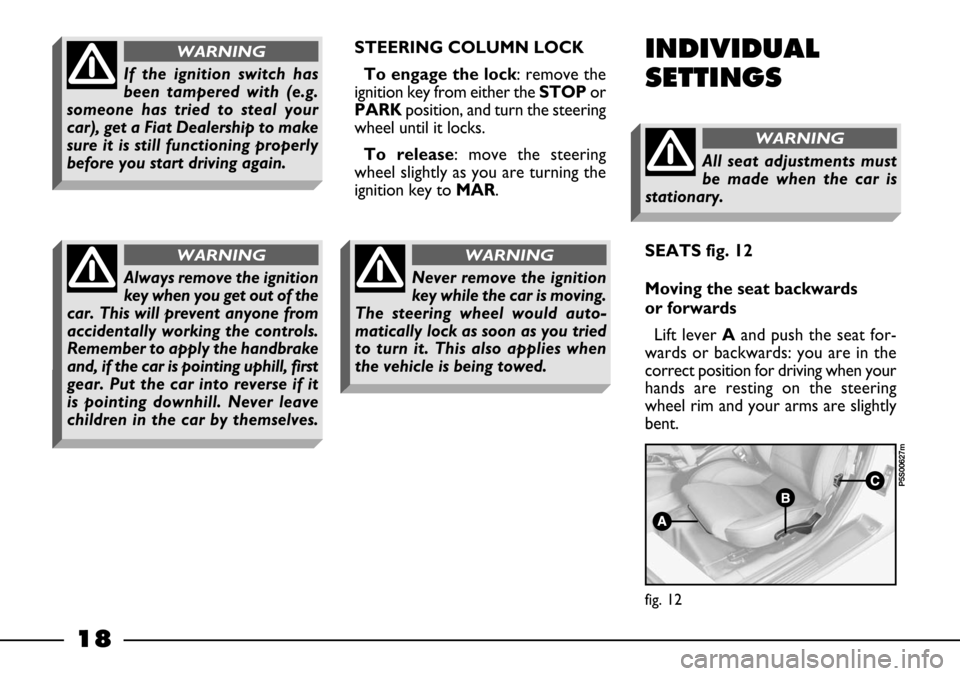
18
If the ignition switch has
been tampered with (e.g.
someone has tried to steal your
car), get a Fiat Dealership to make
sure it is still functioning properly
before you start driving again.
WARNING
Always remove the ignition
key when you get out of the
car. This will prevent anyone from
accidentally working the controls.
Remember to apply the handbrake
and, if the car is pointing uphill, first
gear. Put the car into reverse if it
is pointing downhill. Never leave
children in the car by themselves.
WARNING
STEERING COLUMN LOCK
To engage the lock: remove the
ignition key from either theSTOP or
PARKposition, and turn the steering
wheel until it locks.
To release: move the steering
wheel slightly as you are turning the
ignition key to MAR.INDIVIDUAL
SETTINGS
All seat adjustments must
be made when the car is
stationary.
WARNING
SEATS fig. 12
Moving the seat backwards
or forwards
Lift lever Aand push the seat for-
wards or backwards: you are in the
correct position for driving when your
hands are resting on the steering
wheel rim and your arms are slightly
bent.
fig. 12
P5S00627m
Never remove the ignition
key while the car is moving.
The steering wheel would auto-
matically lock as soon as you tried
to turn it. This also applies when
the vehicle is being towed.
WARNING
Page 23 of 170
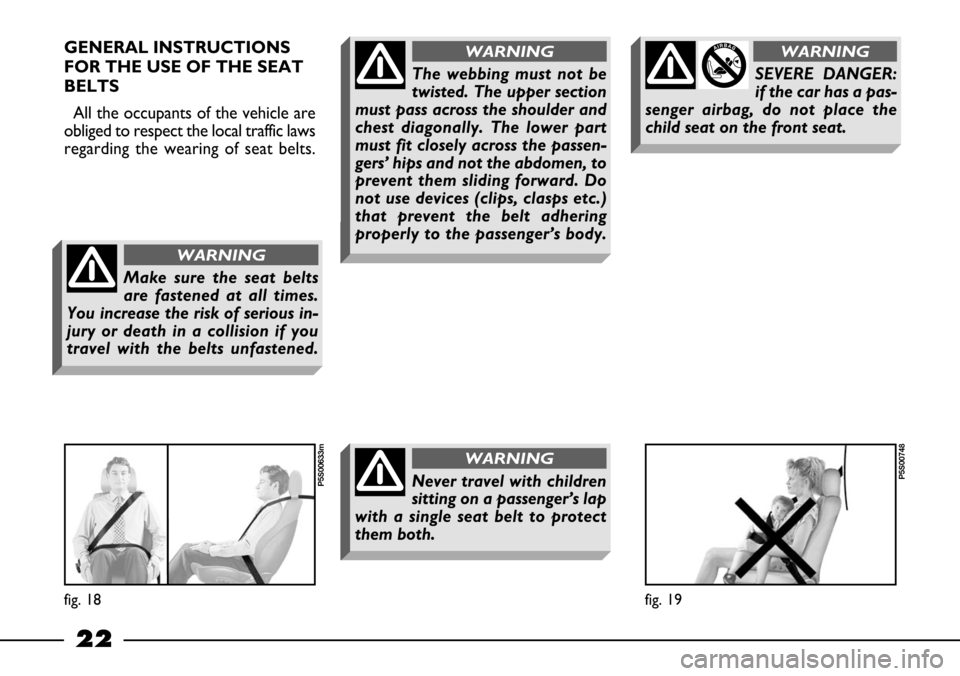
22
GENERAL INSTRUCTIONS
FOR THE USE OF THE SEAT
BELTS
All the occupants of the vehicle are
obliged to respect the local traffic laws
regarding the wearing of seat belts.
Make sure the seat belts
are fastened at all times.
You increase the risk of serious in-
jury or death in a collision if you
travel with the belts unfastened.
WARNING
fig. 18
P5S00633m
fig. 19
P5S00748
The webbing must not be
twisted. The upper section
must pass across the shoulder and
chest diagonally. The lower part
must fit closely across the passen-
gers’ hips and not the abdomen, to
prevent them sliding forward. Do
not use devices (clips, clasps etc.)
that prevent the belt adhering
properly to the passenger’s body.
WARNING
Never travel with children
sitting on a passenger’s lap
with a single seat belt to protect
them both.
WARNING
SEVERE DANGER:
if the car has a pas-
senger airbag, do not place the
child seat on the front seat.
WARNING
Page 24 of 170
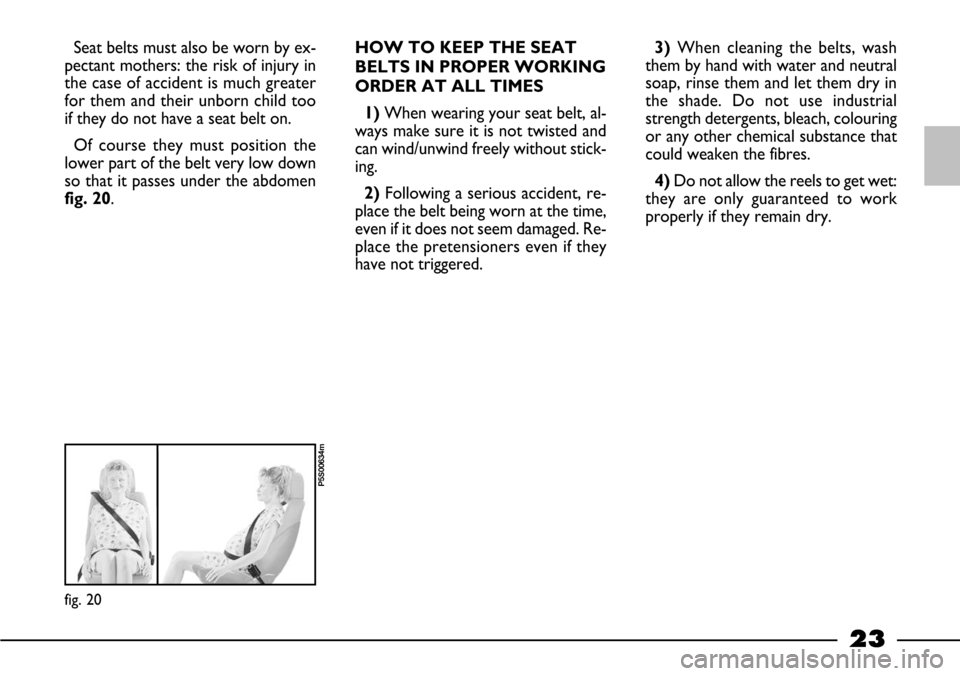
23
Seat belts must also be worn by ex-
pectant mothers: the risk of injury in
the case of accident is much greater
for them and their unborn child too
if they do not have a seat belt on.
Of course they must position the
lower part of the belt very low down
so that it passes under the abdomen
fig. 20.HOW TO KEEP THE SEAT
BELTS IN PROPER WORKING
ORDER AT ALL TIMES
1)When wearing your seat belt, al-
ways make sure it is not twisted and
can wind/unwind freely without stick-
ing.
2) Following a serious accident, re-
place the belt being worn at the time,
even if it does not seem damaged. Re-
place the pretensioners even if they
have not triggered.3)When cleaning the belts, wash
them by hand with water and neutral
soap, rinse them and let them dry in
the shade. Do not use industrial
strength detergents, bleach, colouring
or any other chemical substance that
could weaken the fibres.
4)Do not allow the reels to get wet:
they are only guaranteed to work
properly if they remain dry.
fig. 20
P5S00634m
Page 25 of 170
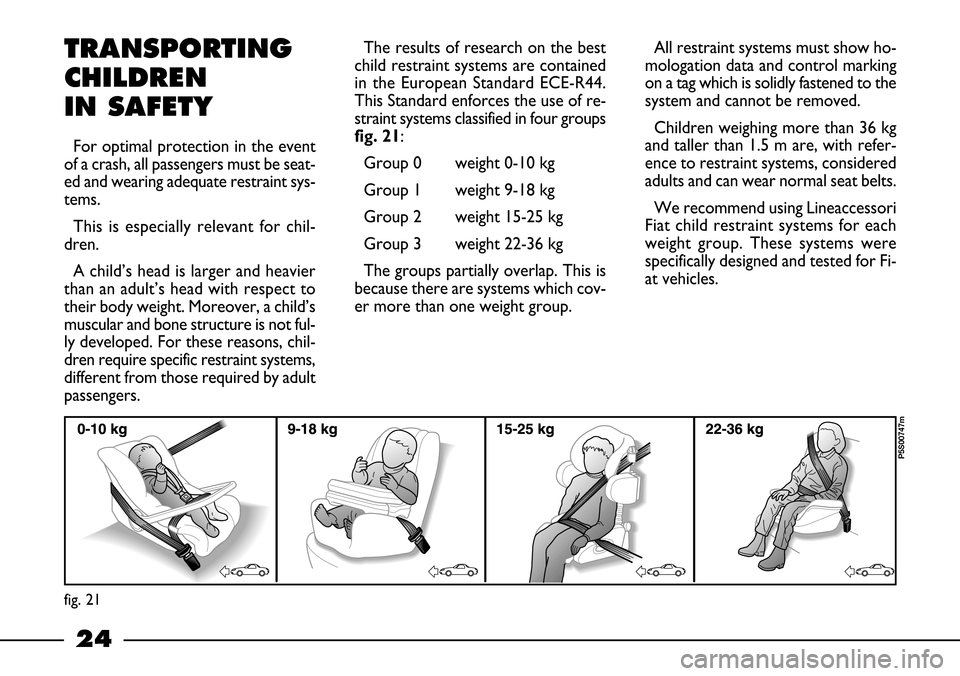
24
TRANSPORTING
CHILDREN
IN SAFETY
For optimal protection in the event
of a crash, all passengers must be seat-
ed and wearing adequate restraint sys-
tems.
This is especially relevant for chil-
dren.
A child’s head is larger and heavier
than an adult’s head with respect to
their body weight. Moreover, a child’s
muscular and bone structure is not ful-
ly developed. For these reasons, chil-
dren require specific restraint systems,
different from those required by adult
passengers.The results of research on the best
child restraint systems are contained
in the European Standard ECE-R44.
This Standard enforces the use of re-
straint systems classified in four groups
fig. 21:
Group 0 weight 0-10 kg
Group 1 weight 9-18 kg
Group 2 weight 15-25 kg
Group 3 weight 22-36 kg
The groups partially overlap. This is
because there are systems which cov-
er more than one weight group.All restraint systems must show ho-
mologation data and control marking
on a tag which is solidly fastened to the
system and cannot be removed.
Children weighing more than 36 kg
and taller than 1.5 m are, with refer-
ence to restraint systems, considered
adults and can wear normal seat belts.
We recommend using Lineaccessori
Fiat child restraint systems for each
weight group. These systems were
specifically designed and tested for Fi-
at vehicles.
fig. 21
P5S00747m
Page 26 of 170
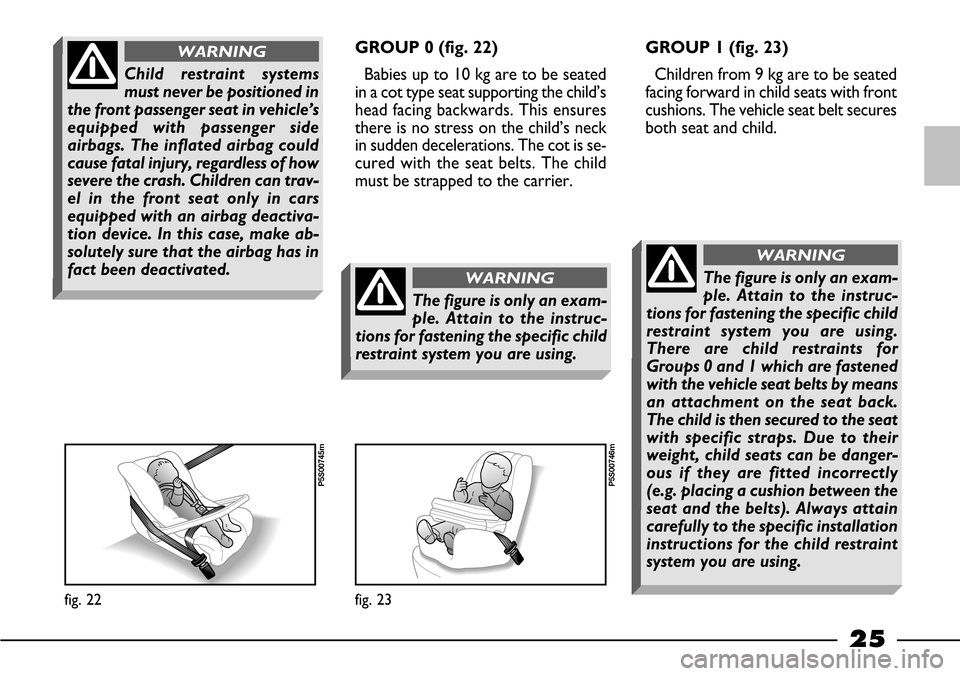
25
GROUP 0 (fig. 22)
Babies up to 10 kg are to be seated
in a cot type seat supporting the child’s
head facing backwards. This ensures
there is no stress on the child’s neck
in sudden decelerations. The cot is se-
cured with the seat belts. The child
must be strapped to the carrier.GROUP 1 (fig. 23)
Children from 9 kg are to be seated
facing forward in child seats with front
cushions. The vehicle seat belt secures
both seat and child.
fig. 22
P5S00745m
fig. 23
P5S00746m
Child restraint systems
must never be positioned in
the front passenger seat in vehicle’s
equipped with passenger side
airbags. The inflated airbag could
cause fatal injury, regardless of how
severe the crash. Children can trav-
el in the front seat only in cars
equipped with an airbag deactiva-
tion device. In this case, make ab-
solutely sure that the airbag has in
fact been deactivated.
WARNING
The figure is only an exam-
ple. Attain to the instruc-
tions for fastening the specific child
restraint system you are using.
WARNINGThe figure is only an exam-
ple. Attain to the instruc-
tions for fastening the specific child
restraint system you are using.
There are child restraints for
Groups 0 and 1 which are fastened
with the vehicle seat belts by means
an attachment on the seat back.
The child is then secured to the seat
with specific straps. Due to their
weight, child seats can be danger-
ous if they are fitted incorrectly
(e.g. placing a cushion between the
seat and the belts). Always attain
carefully to the specific installation
instructions for the child restraint
system you are using.
WARNING
Page 27 of 170

26
GROUP 2 (fig. 24)
Children from 15 kg can be secured
directly with the vehicle seat belts. The
child seat has the purpose of posi-
tioning the child correctly with respect
to the seat belt so that the diagonal
section crosses the child’s chest (nev-
er the child’s throat) and the hori-
zontal section fits snugly on the child’s
hips (and not the child’s abdomen). GROUP 3 (fig. 25)
Children from 22 kg up only require
a cushion to lift them. The size of the
child’s chest no longer requires a sup-
port to space the child’s back from the
seat back.
Children taller than 1.5 m can wear
seat belts like adults.To sum up the safety precau-
tions to follow when transporting
children:
1) Child restraint systems should be
installed on the rear seat as this is the
most protected area in the vehicle in
the event of a crash.
2) Attain to the instructions for fas-
tening the specific child restraint sys-
tem you are using which must be pro-
vided by the manufacturer. Keep the
child restraint system installation in-
structions with this the vehicle docu-
ments and with this Handbook. Nev-
er use a child restraint system without
installation instructions.
3) Always check the seat belt is well
fastened by pulling the webbing.
4) Only one child can secured to a
child restraint at a time. Never carry
two children in one restraint system.
5) Always check the seat belts do
not fit around the child’s throat.
6) While travelling, do not let the
child sit incorrectly or release the
belts.
7)Passengers should never carry
children or babies on their laps. No-
one, however strong they are, can
hold a child in the event of a crash.
8) Replace the child restraint system
after an accident.
fig. 24
P5S00749m
fig. 25
P5S00750m
The figure is only an exam-
ple. Attain to the instruc-
tions for fastening the specific child
restraint system you are using.
WARNING
The figure is only an exam-
ple. Attain to the instruc-
tions for fastening the specific child
restraint system you are using.
WARNING
Page 60 of 170
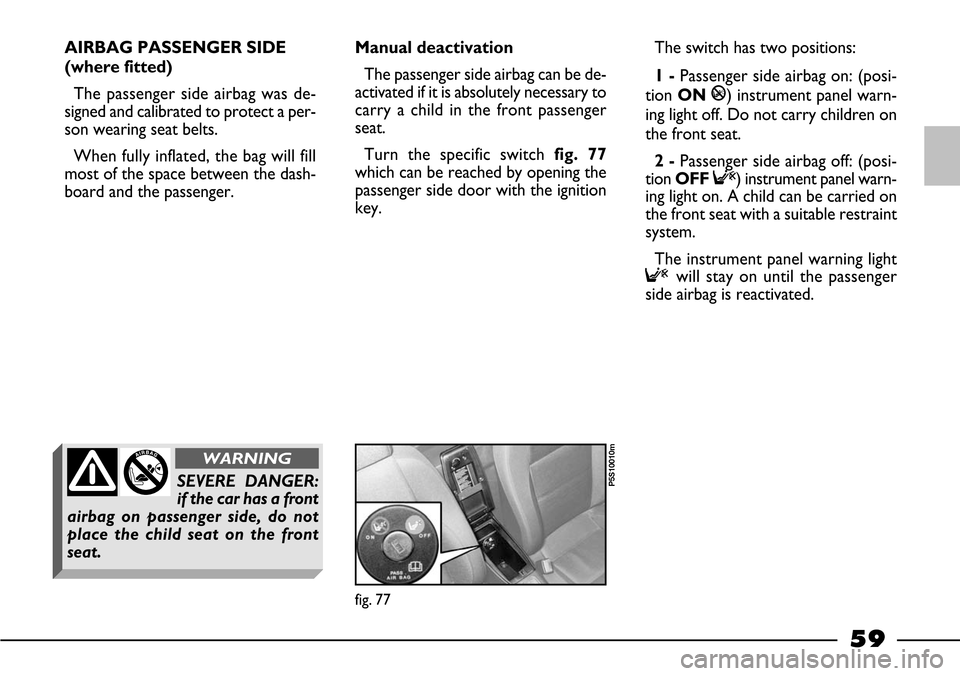
59
AIRBAG PASSENGER SIDE
(where fitted)
The passenger side airbag was de-
signed and calibrated to protect a per-
son wearing seat belts.
When fully inflated, the bag will fill
most of the space between the dash-
board and the passenger. Manual deactivation
The passenger side airbag can be de-
activated if it is absolutely necessary to
carry a child in the front passenger
seat.
Turn the specific switch fig. 77
which can be reached by opening the
passenger side door with the ignition
key. The switch has two positions:
1 - Passenger side airbag on: (posi-
tion ON
P) instrument panel warn-
ing light off. Do not carry children on
the front seat.
2 -Passenger side airbag off: (posi-
tion OFFF) instrument panel warn-
ing light on. A child can be carried on
the front seat with a suitable restraint
system.
The instrument panel warning light
Fwill stay on until the passenger
side airbag is reactivated.
SEVERE DANGER:
if the car has a front
airbag on passenger side, do not
place the child seat on the front
seat.
WARNING
fig. 77
P5S10010m
Page 62 of 170

61
Do not apply stickers or
other objects to the steer-
ing wheel or to the dashboard on
the passenger’s side. Do not travel
with objects on your lap or in front
of you nor with a pipe, pencil or
similar between your lips; you could
seriously hurt yourself if the airbag
inflates in a collision.
WARNING
The correct operation of
the front airbags and pre-
tensioners is only ensured if the car
is not overloaded.
WARNING
The airbag does not replace
seat belts but rather in-
creases their effectiveness. Further-
more, the front airbag is not fired in
the event of low speed front colli-
sions, side collisions, rear-end shunts
and roll-overs. In these cases, the
passengers are only protected by
the seat belts which for this reason
must always be fastened.
WARNING
Always drive with both
hands on the rim of the
steering wheel so that the airbag is
free to inflate during a head-on col-
lision, and protect you from serious
injury. Do not drive with your body
bending towards the steering wheel,
but sit in an upright position with
your back resting against the seat.
WARNING
If an attempt has been
made to steal the car, or if
it has actually been stolen or has
been vandalised in any way or sub-
jected to flooding, have the airbag
system checked over at a Fiat Deal-
ership.
WARNING
It is important to remember
that when the ignition key
is turned to MAR even if the engine
is off, the air bag can be fired when
the car is stationary if it hit by an-
other vehicle travelling at suitable
speed. As a consequence, Fiat rec-
ommends sitting children in their
specific retainer system on the back
seat, which is the most protected
position ossible. On the contrary,
the air bags will not be fired in the
car is crashed into when the key is
not insered or turned. Consequent-
ly, in this case, the fact that the
asystem is not fired does not indi-
cate a fault.
WARNING